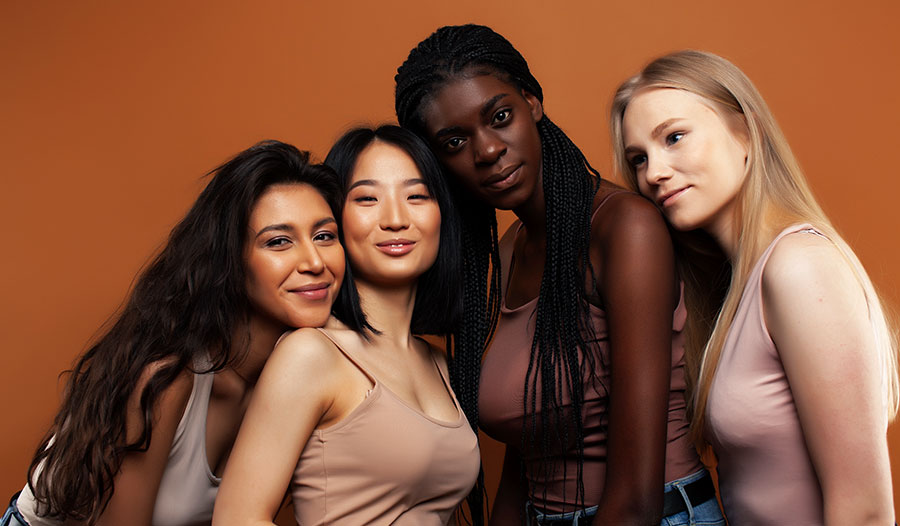Tips for Healthy and Full Hair Growth
DISCLAIMER:This blog does not intend to provide diagnosis...
- In this article:
- Hair Breakage
- Dry, Brittle Hair
- Scalp Flaking
- For Thinning Hair

Though we all have that friend that makes it look easy, achieving and maintaining healthy hair can be surprisingly difficult and confusing. We’d all love to have a thick, shiny, head of hair, but all too often we unwittingly fall prey to common hair care practices that do more harm than good in the never-ending quest to keep up with the latest styling trends.
As someone with curly hair, I grew up with my fair share of struggles in learning how to care for my hair. Years later, as a dermatologist, I see and treat hair and scalp disorders daily, and witness firsthand many patients making some of the same mistakes I once made.
Read on to dive into some common conditions I see in my clinic, and for ways you can optimize your hair and scalp health.
Hair Breakage
We’ve all been there—religiously pulling out a blow dryer, flat iron, or curling wand to get that polished, effortless look we saw our favorite celebrity sporting on a magazine cover. Sitting for hours in the chair at the salon to get that perfect shade of blonde to freshen up our look just in time for summer. The way we style and color our hair influences our hair health—improper use of heat, for example, can lead to dry, brittle hair that breaks easily. Intuitively, we know it’s probably not great to apply 400-degree heat directly to our delicate strands—but we do it anyway.
So, how do heat and chemicals damage hair, and why does this lead to breakage and hair loss? These traumatic external insults are thought to damage the protective outer layer of the hair shaft called the cuticle. In turn, the protein structure of the hair is altered, leading to a condition called acquired trichorrhexis nodosa, a common anomaly of the hair shaft in which weak points form along the hair, manifesting as dry, lusterless hair that breaks easily at said weak points.
If you’re going to use heat styling practices (and I know you will!), here are some tips to keep in mind to minimize or even prevent thermal damage:
- Use the lowest heat setting possible to achieve your desired result—hotter does not always mean better!
- Try your best to decrease how frequently you reach for heat styling tools—can you get away with three times per week instead of daily? Or, how about only using them weekly?
- Limit the amount of time your hair is actually in contact with the flat iron, curling iron, or curling wand.
- Let your hair air dry when possible—to speed up that process and protect those locks, try a hair towel wrap, an absorbent, stretchy cotton towel that gently allows for frizz-free and heat-free hair drying.
- Apply a heat protectant before styling. A professional-grade heat protectant can help guard against damage from the heat and friction of styling tools.
Dry, Brittle Hair
Often, hairdressers are the ones fielding questions about what products to use to address dull, dry hair. Occasionally, however, patients bring these concerns to me as well. As long as we’ve also addressed any underlying or concurrent scalp issues, I usually start my discussions on maintaining healthy hair by discussing shampoo and conditioner.
Hair shampoos are designed not only to clean the hair, but to cleanse the scalp from dirt, pollutants, excess oils, dead skin, and other greasy residues. Though most shampoos are also formulated with conditioning agents so as to minimize frizz, stand-alone conditioners are designed specifically to improve hair manageability, decrease hair static electricity, and add luster and shine by replacing the natural oils removed during the shampooing process. In addition, conditioners can help treat hair following chemical and thermal treatments straightening, blow-drying, and coloring.
Here are some ingredients I recommend seeking out for cleansing and conditioning:
Shea butter conditioners
This ingredient has long been touted by curly-haired folks as a staple, for good reason. Shea butter leave-in conditioners can be used in daily styling to help reduce frizz and protect against split ends or as an intensive overnight conditioning treatment.
Argan oil, shea butter, and amino acids
Shampoos and conditioners with this trio can provide maximum moisturizing for dry, wavy, and curly hair, while being gentle enough to use on colored hair.
Coconut Oil
Coconut oil is abundant in saturated fats—great not just for moisturizing hair and scalp, but also rough, dry skin.
Scalp Flaking
Healthy hair starts with a healthy scalp—and that means addressing any underlying inflammatory conditions that may hinder optimal hair growth, particularly if that condition causes itching, leading to frequent rubbing and scratching that definitely isn’t great for hair growth.
Psoriasis is a chronic inflammatory disease of the skin that often affects the scalp, manifesting as redness, flaking, and scaling. The cause is thought to be multifactorial, resulting from a combination of genetics and external factors such as stress and infections. Another very common chronic scalp condition treated routinely by dermatologists, which shares some overlapping features with psoriasis, is called seborrheic dermatitis —though most of us know it simply as “dandruff.” Seborrheic dermatitis predominantly occurs in areas of skin with high concentrations of sebaceous glands including the face, ears, chest, and scalp. Overproduction of sebum, the oil produced by sebaceous glands, facilitates the growth of a yeast called Malassezia. This yeast is a normal part of skin flora, even in individuals without dandruff, so it is not entirely understood why some seem to have an immune response to it while others do not. Nevertheless, because this link between dandruff and Malassezia has been proven, we can use a variety of medications to target both the yeast itself and associated inflammation. The list below highlights some great ingredients for the treatment of seborrheic dermatitis and psoriasis; think of these as scalp therapies, not hair therapies, so for best results follow with your usual shampoo and conditioning routine to avoid drying out the hair itself!
Coal Tar
Coal tar is a favorite over-the-counter solution to stubborn dandruff and can also be helpful for the scaling, itching, and flaking seen in psoriasis affecting the scalp. It works to loosen up dead skin cells and decrease skin cell turnover, thereby reducing scale formation.
Salicylic acid
Salicylic acid helps to address thick scaling which can lead to irritation, itching, and redness associated with psoriasis and seborrheic dermatitis.
Pyrithione zinc
Pyrithione zinc can be found in many anti-dandruff shampoos and works to inhibit the growth of fungus and yeast thought to be central to driving the inflammation related to dandruff.
Selenium sulfide
Rounding out the flake-fighting ingredients is selenium sulfide, which can be found in many anti-dandruff shampoos and also has anti-fungal properties.
For Thinning Hair
Hair loss is a deceptively complex topic that could fill an entire dermatology textbook, so it should come as no surprise that one small section of a blog article on healthy hair tips is just barely going to skim the surface. There are many causes of hair loss—genetics, stress, medications, hormonal shifts, rapid weight loss, nutritional deficiencies, or any combination of the above may play a role in hair loss. For common, male and female pattern hair loss caused by a combination of genetics and aging, here are some useful products:
B Vitamins and Caffeine
B Vitamins, including niacinamide (vitamin B3) and panthenol (a form of vitamin B5) in combination with caffeine, are commonly found in thickening shampoos. Together, these ingredients are thought to stimulate hair follicles and increase the hair shaft diameter, creating the appearance of a thicker, fuller head of hair.
Marine Collagen
We know that collagen is essential for hair growth, providing proteins and amino acids to make keratin. Marine collagen derived from wild-caught cod fish has good scientific data behind it to support its use as a nutritional supplement to boost hair growth. Please note, this supplement has not been studied in pregnant patients and I, therefore, recommend avoiding it in pregnancy.
For persistent, rapid, or progressively worsening hair loss it’s best to see a dermatologist as soon as possible to determine the cause, rule out underlying conditions, and develop a comprehensive treatment plan.
As always, don’t hesitate to reach out if you have additional questions. Here’s to reaching your hair goals in 2022!
References:
- D'Souza, P., & Rathi, S. K. (2015). Shampoo and Conditioners: What a Dermatologist Should Know?. Indian journal of dermatology, 60(3), 248–254. https://doi.org/10.4103/0019-5154.156355
- Farris, P. K., Rogers, N., McMichael, A., & Kogan, S. (2017). A Novel Multi-Targeting Approach to Treating Hair Loss, Using Standardized Nutraceuticals. Journal of drugs in dermatology : JDD, 16(11), s141–s148.https://pubmed.ncbi.nlm.nih.gov/29141069/
- Haskin, A., Kwatra, S. G., & Aguh, C. (2017). Breaking the cycle of hair breakage: pearls for the management of acquired trichorrhexis nodosa. The Journal of dermatological treatment, 28(4), 322–326. https://doi.org/10.1080/09546634.2016.1246704
- Nestle, F. O., Kaplan, D. H., & Barker, J. (2009). Psoriasis. The New England journal of medicine, 361(5), 496–509. https://doi.org/10.1056/NEJMra0804595
- Pechère, M., Krischer, J., Remondat, C., Bertrand, C., Trellu, L., & Saurat, J. H. (1999). Malassezia spp carriage in patients with seborrheic dermatitis. The Journal of dermatology, 26(9), 558–561. https://doi.org/10.1111/j.1346-8138.1999.tb02048.x

 By Dr. Brittany Oliver, M.D., F.A.A.D.
By Dr. Brittany Oliver, M.D., F.A.A.D.


